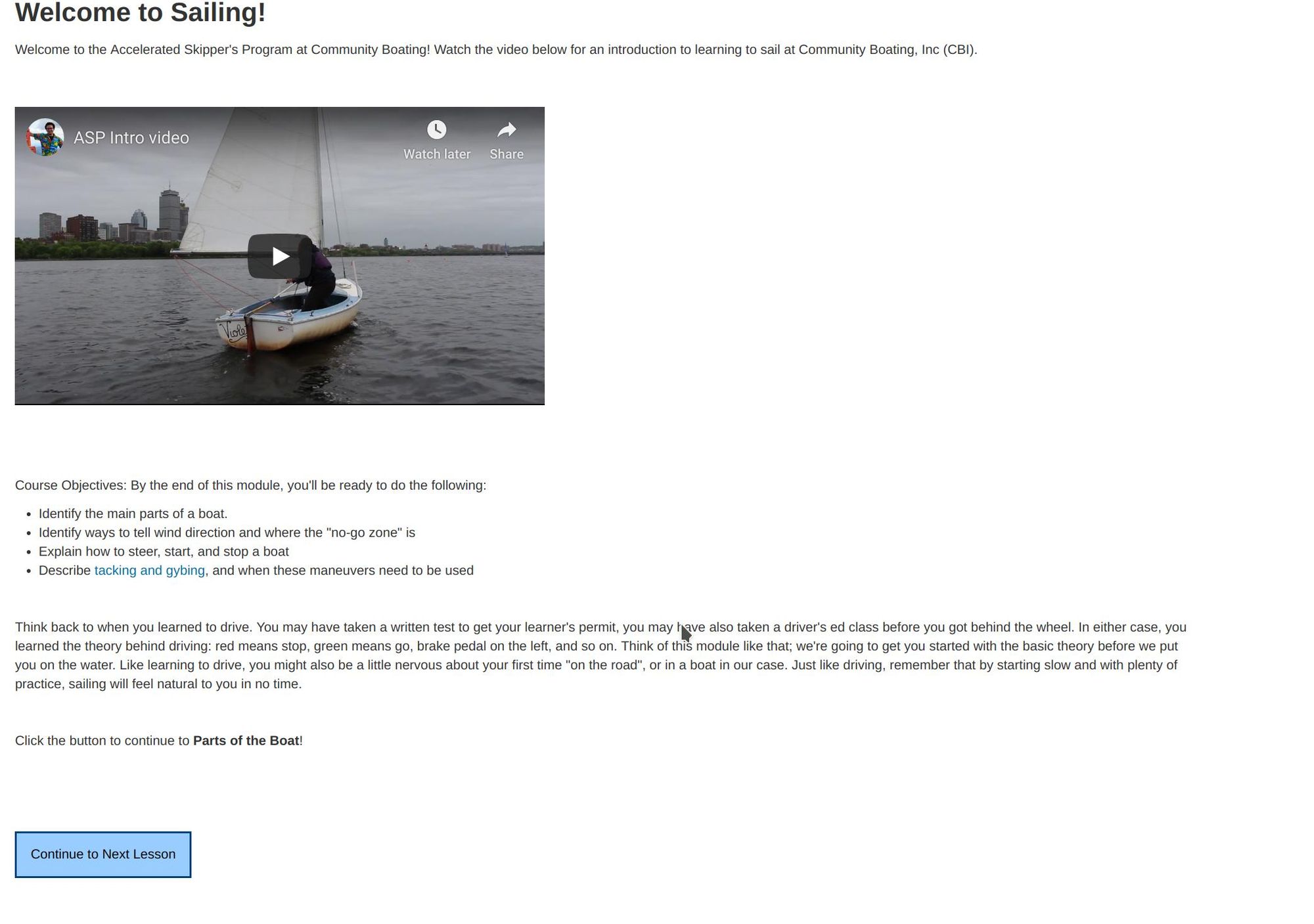High Tech Sailing Lessons with the Moodle LMS
Like learning to drive as a teenager, learning to sail can be intimidating as an adult. Similarly, driving and sailing both require some basic theoretical knowledge beforehand: red means stop in driving and port means left in sailing. To alleviate the worries of new adult sailors and prep them on the basics, I developed a fully online sailing course which teaches students the basics before they get on the water. We at Community Boating called it the Accelerated Skipper's Program (ASP), and it used a media rich format within the Moodle Learning Management System. The result was a high quality learning experience accessible to busy adults in their homes, built at a minimal cost, using the best of both open source and proprietary multimedia technology.

Importance
This online class stands out for its technical depth and heavy use of media, but more importantly it also showcases what free and open source technology can produce while keeping costs down and quality high. Developing lessons online also synthesizes a number of different talent areas beyond the initial Instructional Design. The full development process also necessitates visual & artistic design, web development with HTML, CSS, and Javascript, system administration, and quality control. In the case of this particular project, I was able to carry out each of these roles to deliver a polished product.
Skills
Multimedia Authoring - The online module for the ASP was extremely media rich, to help make the connection between the material on the learner’s screen and the on-the-water environment. Still images were shot and edited by myself using both the open source GIMP software package as well as Adobe Lightroom and Photoshop. I also shot the video and edited it using the free editing suite Lightworks. Lightworks was also used to create stop-motion videos of key sailing maneuvers, all of which were drawn, planned, and recorded by me. Lastly, I developed looping animated GIFs to display physical maneuvers using Adobe Photoshop.
Building with an LMS - Not only was this module entirely built using the open-source Moodle LMS, but the underlying technology was also installed and configured by myself. Using an LMS like Moodle means that the starting point for this module was a blank canvas. Unlike an LMS like Blackboard, the blank canvas of Moodle means all page flows, modules, content types, and assessments were chosen deliberately for this specific learning challenge, instead of relying on prefabricated lesson formats.
HTML/CSS/Server Administration - The Moodle instance was installed from scratch on a dedicated server owned by my company. Supporting it was a classic LAMP stack, each component installed and configured by myself. A LAMP stack consists of:
Linux - An open source operating system I installed on the server
Apache - One of the oldest and most common open source webservers
MySQL - A common open source database management system
PHP - A scripting language used by the server
Additionally, I used custom HTML and CSS to alter the look and page flow of the lesson to suit the needs of the learner.
Impact
The ultimate result of this project is that Community Boating received a product that met their immediate needs for a low startup cost and minimal recurring cost. Without having to pay for proprietary software licenses or subscriptions, the only cost to host and maintain the lesson is the electricity to run the server. In this way, Community Boating can offer an affordable and highly scalable easy introduction to sailing that will entice corporate clients, who prefer to learn the basics with the convenience of online learning. Because of this, the project highlights the importance of selecting the technologies that are germane to the learning design, instead of relying on trendy (and costly) software suites that may deploy quickly but don’t exactly meet your needs. In this case, open source technology for the most part provided the solution, but limitations exist that designers must be aware of. The cost of software licenses for Adobe products, and the labor required to set up the LMS are not trivial. In all, the key takeaways from this project are that technology can have an impact even for a physical activity like sailing, but that technology should be deployed deliberately and thoughtfully by someone who understands it deeper than the surface level.
Work Samples
An Animated GIF made used to demonstrate the "heading up" maneuver. The GIF was made from a video recorded on a digital SLR camera, which was edited in Lightworks, and turned into a GIF using Adobe Photoshop.

Conclusion video from the lesson edited in Lightworks: